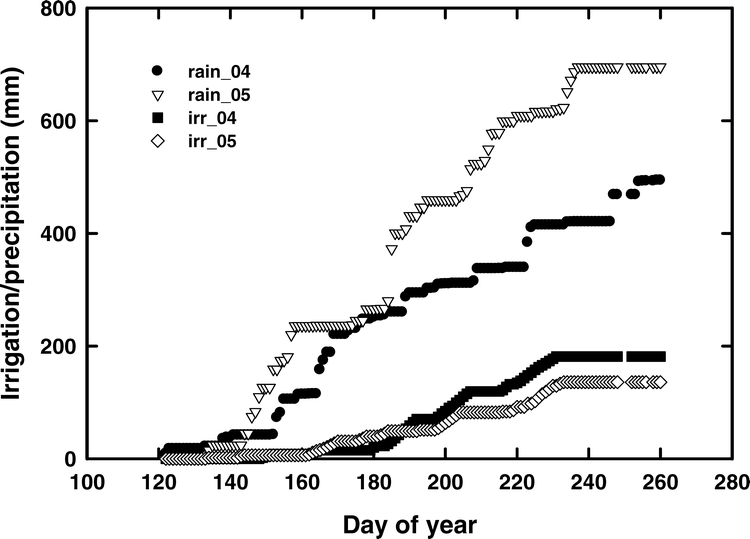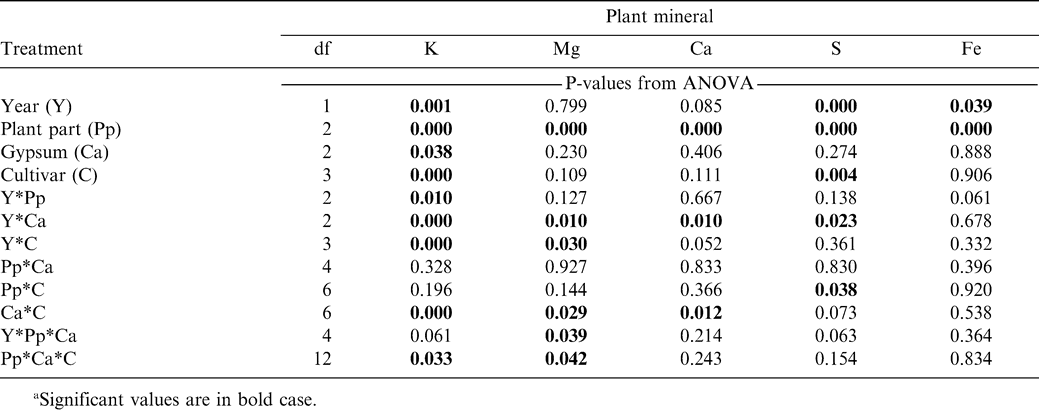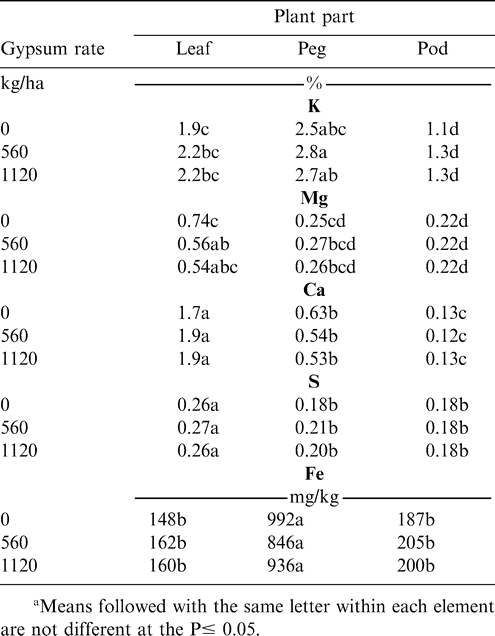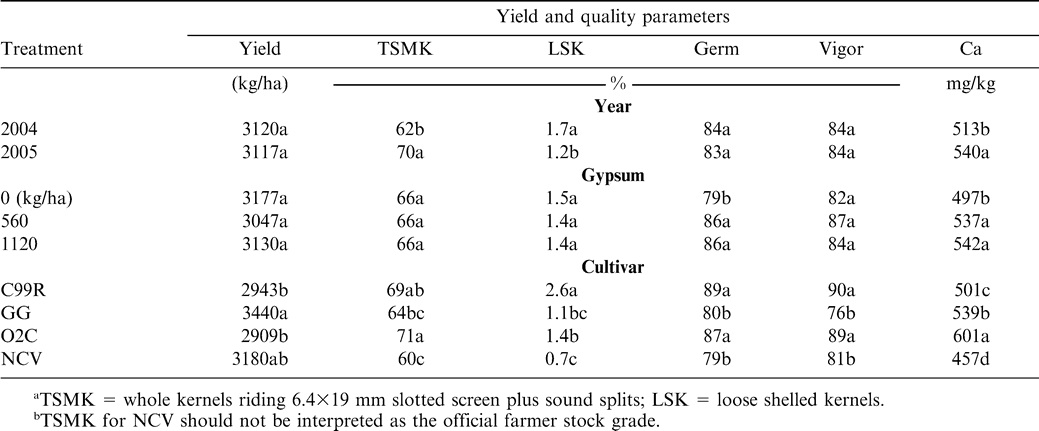Introduction
Calcium is a highly required mineral for increased peanut yield and grade (Cox et al, 1982). Lower concentrations of calcium in the peanut pegging zone can result in low pod yield, grade, and germination. There is little or no transport of calcium from the roots to the leaves and back to the pod via the phloem through the peg, thus calcium uptake must be through the developing pod (Wiersum, 1951; Sumner et al., 1988). This implies that two conditions must occur for calcium uptake to the plant or to the pod; 1) there must be enough soil moisture in the pod zone for water uptake by roots and pods, and 2) calcium must be present in sufficient concentrations to dissolve into the soil water for uptake into the roots and pods. If one or both of these conditions does not occur, then yield and grade may be reduced. Additions of calcium sulfate (gypsum) and irrigation by overhead sprinkler systems assure that neither water nor calcium is deficient. Various researchers have shown the importance of calcium rate and timing with relationship to yield of both runner and Virginia type peanut (Adams and Hartzog, 1991; Adams et al., 1993; Jordan et al., 2000; Wiatrak et al., 2006; Grichar et al., 2004). Most research was accomplished using overhead irrigation or non-irrigated conditions. Currently, there is no research information available describing pod yield and calcium fertilization when irrigated with subsurface drip irrigation (SDI).
Irrigation systems using SDI have the capability of frequently supplying water to the root zone while reducing the risk of cyclic water stress that is typical of other irrigation systems or nonirrigated production (Phene et al., 1987). Subsurface drip systems are adaptable to variations of field shape making them an important consideration in the Southeast. In recent years, drip irrigation has been expanded with good success on field crops such as corn (Zea mays L.) (Lamm et al., 1997, 2001; Mitchell, 1981; Mitchell and Sparks, 1982; Powell and Wright, 1993), cotton (Gossypium hirsutum L.) (Camp et al. 1997; Sorensen et al., 2004), and peanut (Jordan et al., 2002; Sorensen et al., 2001a, b; Zhu et al., 2004). Irrigation SDI laterals have been installed at 0.2 and 0.3 m soil depths (Bucks et al., 1981; Camp et al., 1989; Phene et al., 1987; Tollefson, 1985) on cotton, corn, fruits, and vegetables. Drip laterals have been spaced at 1, 2 and 3 m apart with various crops with yields decreasing as lateral spacing increases greater than 2 m (Camp et al., 1997; French et al., 1985; Lamm et al., 1992; Powell and Wright, 1993). Bosch et al. (1998) showed that 1.83 m lateral spacing in corn-peanut rotations had the highest returns on sandy soils in Virginia-North Carolina region.
SDI systems may be efficient in supplying water and nutrients to the root zone, but may not be efficient in supplying water to the peanut peg zone where water is needed to move calcium into the developing fruit. The objective of this research was to determine the efficacy of current calcium recommendations when using SDI systems by documenting yield response and mineral concentration of peanut plants to three calcium application rates when irrigated with SDI.
Materials and Methods
A SDI system was installed in the spring of 2000 near Sasser, GA on Tifton loamy sand (fine-loamy, kaolinitic, thermic Plinthic Kandiudults) with 2 to 5% slope. The SDI system had drip laterals buried at 0.3 m deep and spaced at 0.91 m with emitters spaced at 0.3 m. Water flow rate was 5.6 L/min per 100 m or 1.0 L/hr per emitter. Peanut was planted following cotton in adjacent sites during the 2004 and 2005 growing seasons.
The experiment was a factorial design with three calcium (gypsum) rates and four peanut cultivars replicated four times. Calcium rates were none, 560 and 1120 kg/ha. Peanut cultivars selected were C99R, Georgia Green (GG), NCV-11 (NCV), and GA-O2C (O2C). Individual plots were 1.83 m wide by 12 m long for a total of 48 plots.
Land preparation was the same both years with disk harrowing two times followed by an experimental bedder (USDA-ARS-National Peanut Research Laboratory, Dawson, GA) used to make 1.83 m beds. Peanut was planted in a twin-row orientation using a commercial vacuum type planter (Monosem planter, ATI Inc, Lenexa, KS). Twin-row orientation was planted at 1.17 m outside rows by 0.7 m inside rows with 0.22 m between the twin-rows with four rows on a bed. Seeds were planted at rates recommended for reducing the risk of Tomato Spotted Wilt Virus (Brown et al., 2004). Pest management practices, i.e., disease, insect, and weed control, followed University of Georgia Agricultural Extension Service recommendations for peanut production (Prostko, 2004). Decisions to apply pest management practices were determined by field scouting. Irrigation water was applied daily based on replacement of crop water use for peanut described by Stansell et al. (1976) except when precipitation amounts exceeded estimated water use.
A composite soil sample (0 to 30 cm) was taken in early spring for fertility recommendations. Initial pH for 2004 and 2005 was 6.3 and 6.2, respectively. The initial Ca concentration was 405 (2004) and 397 mg/kg (2005). Gypsum was applied by hand over individual rows at first flower or 40 days after planting (DAP), whichever came first. Soil and plant samples were taken 80 DAP and analyzed for mineral nutrition (Waters Agricultural Laboratories, Inc. Camilla, GA). A composite of 6 sub-samples in each plot were taken at the 0 to 5 cm soil depth. Three plants were randomly selected in each plot for chemical analysis. Plants were partitioned into leaves, pegs, and pods. At the 80 DAP sampling period, the pods were immature such that peanut kernels were not separated from the hulls before analysis.
Cultivars were dug individually at maturity determined by the hull scrape method (Williams and Drexler, 1981). Yield rows were dug with a 2-row inverter and combined with a stationary plot combine (Kingaroy Engineering Works, Ltd., Kingaroy, Australia). Pod yield was determined after being mechanically dried, weighed, and adjusted to 7% moisture (wet basis). Since Virginia type peanuts require different screen openings compared with runner type peanuts for market grade, farmer stock grade and kernel size distribution for all peanut cultivars were determined using screens specified in USDA grading procedures (USDA, 1993) for a runner type peanut. It is understood that Virginia type peanut will not have a valid market grade with this procedure while runner type peanuts will have a valid market grade. Mineral analysis was performed on kernels that rode an 8.3×19 mm slotted screen. Germination, vigor (cold test germination), and calcium concentrations were determined from a 250 g kernel subsample (riding a 6.4×19 mm slotted screen) by the Georgia Department of Agriculture (Tifton, GA).
Plant, kernel, and soil analysis along with pod yield and farmer stock grade were analyzed using a general analysis of variance procedure (Statistix8, 2003). Tukey's HSD least significant difference range test was used to show differences among means (P ≤ 0.05) when ANOVA F-test showed significance.
Results and Discussion
Precipitation during the peanut growing season was less in 2004 (494 mm) compared with 2005 (695 mm) (Fig. 1). Cumulative irrigation amount shows less water applied through the drip system in 2005 (136 mm) compared with that applied in 2004 (181 mm). The disparity between irrigation totals for 2004 and 2005 was not as great as the difference between precipitation amounts for those same years. Cumulative precipitation patterns in 2005 shows about a 30 day period with little precipitation followed by a large precipitation event (day 152 to 182). This pattern of drought followed by precipitation events occurred both years and is typical of the southeast. In 2005, one large storm pattern accumulated over 180 mm in a ten day period (day 184 to 194) which was more than 25% of the total precipitation for the growing season.
Soil Analysis
There was a year, Ca level, and year by Ca level interaction depending on chemical element (Table 1). Both years, before gypsum was applied there were differences across the various plots with K, Mg, and S. A change in year was also a change in location of the plots. Both plots (2004 and 2005) had the same soil series and were adjacent to each other. Differences in fertility by year can be attributed to change in location as well as mineral nutrition history from previous years when managing each site independently for maximum yield for the previous crops. There was no difference in the year by calcium level interaction before gypsum was applied, but there were differences in calcium concentration after application. It was expected that the calcium rate should show differences due to the amount of gypsum applied at the various rates. As expected, both Ca and S increased as gypsum was applied, 5% and 20%, respectively (data not shown). With a change of site (year) there were differences in K, Mg, and S concentration both before and after gypsum application while soil Ca did not change with year (data not shown). The Ca∶K ratio should be 3∶1 for best yield and reduce the risk of interference of Ca uptake by K (Hallock and Garren, 1968). Soil Ca∶K ratio before gypsum addition was 7.6∶1 and after application was 9.8∶1. The lowest ratio was 5.5∶1 in 2004 when gypsum was applied during the growing season (data not shown).
Plant Analysis
Mineral analyses of peanut plants show that year, plant partitions (leaves, pegs, and kernels), cultivar, and associated interactions have differing mineral concentrations (Table 2) depending on specific mineral and treatment. Ca concentration was different for specific plant parts but not by year, calcium level or cultivar (Table 2). Sulfur on the other hand was not different for calcium level but was different for year, plant part, and cultivar. It was expected that peanut would have different mineral analysis by year, plant part, and cultivar due to different growing conditions, site location, and soil amendments applied.
Calcium concentrations were 3 and 14 times higher in leaves compared with pegs and pods, respectively (Table 3). These data coincide with results from Grichar et al., (2004) that showed Ca concentrations were higher in leaves compared with pods (hulls or kernels). Sulfur concentrations were 1.4 times higher in leaves compared to pegs and pods. Both pegs and pods had the same S concentration. Potassium and Mg had mixed concentrations between all three plant parts with pods tending to have lower concentrations compared with leaves or pegs. Iron concentrations were excessively high in the peg compared with those in leaves or pods (Table 3) and irrespective of gypsum level.
Peanut Yield and Quality
There was no pod yield by year or calcium level difference (Table 4). The grade parameters of Total Sound Mature Kernels (TSMK) and Loose Shelled Kernels (LSK) showed differences by year and cultivar but not with calcium rate. Kernel calcium concentration was different by year, calcium level, and cultivar. Both germination and vigor percentage were different for calcium level and cultivar but not by year (Table 4).
The cultivars GG and NCV had the same pod yield (Table 5). Cultivars C99R and O2C had the same yield as NCV but were less than GG. Previous research shows that pod yield is not necessarily increased as levels of calcium increase (Adams and Hartzog, 1991; Adams et al., 1993; Jordan et al., 2000; Wiatrak et al., 2006). It would seem that the addition of calcium may not always affect yield but may influence disease reduction (Grichar et al., 2004), pod development, and germination (Cox et al., 1976).
The cultivar O2C had the highest TSMK (71%) followed by C99R and GG (64 and 69%, respectively) while NCV had the lowest TSMK (60%). These data are different than those presented by Main et al. (2002) and Wiatrak et al. (2006) which showed that GG had higher TSMK than C99R.
Calcium concentration in the peanut kernel was higher when gypsum was applied compared with no gypsum (Table 5). The addition of gypsum had no effect on yield, TSMK, LSK, or peanut vigor while the addition of gypsum did influence germination. The cultivar, O2C had the highest calcium concentration in the kernels followed by GG, C99R, and finally, NCV. Germination and vigor were highest in O2C and C99R (88%) followed by GG and NCV (80%) (Table 5).
Conclusions
Pod yield for peanut cultivars in this research are comparable with those reported by Wiatrak et al. (2006) and Jordan et al. (2000). Kernel calcium levels were higher than calcium levels described by Grichar et al. (2004). Germination and vigor percentages were within acceptable limits. Fields that are irrigated with SDI have similar pod yield, farmer stock grade, and quality as reported fields with overhead irrigation; however, there was no yield response to increasing Ca rates in this study. Based on this study, there is no evidence indicating a change in calcium recommendations for subsurface drip irrigation on peanut is needed.
Literature Cited
Adams J. F. and Hartzog D. L. 1991 Seed quality of runner peanuts as affected by gypsum and soil calcium. J. Plant. Nutr 14 : 841 – 851 .
Adams J. F. , Hartzog D. L. , and Nelson D. B. 1993 Supplemental calcium on yield, grade, and seed quality of runner peanut. Agron. J 85 : 86 – 93 .
Bosch D. J. , Powell N. L. , and Wright F. S. 1998 Investment returns from three sub-surface microirrigation tubing spacings. J. Prod. Agric 11 / 3 : 371 – 376 .
Brown S. , Todd J. , Culbreth A. , Baldwin J. , Beasley J. , Kemerait B. , Prostrko E. , and Smith N. 2004 Minimizing spotted wilt of peanut. Extension Bulletin 1165. Ga. Agric. Exp. Stn. Athens, GA.
Bucks D. A. , Erie L. J. , French O. F. , Nakayama F. S. , and Pew W. D. 1981 Subsurface microirrigation management with multiple cropping. Trans. ASAE 24 / 6 : 1482 – 1489 .
Camp C. R. , Sadler E. J. , and Busscher W. J. 1989 Subsurface and alternate-middle microirrigation for the southeastern coastal plain. Trans. ASAE 31 / 2 : 451 – 456 .
Camp C. R. , Bauer P. J. , and Hunt P. G. 1997 Subsurface drip irrigation lateral spacing and management for cotton in the southeastern coastal plain. Trans ASAE 40 / 4 : 993 – 999 .
Cox F. R. , Sullivan G. A. , and Martin C. K. 1976 Effect of calcium and irrigation treatments on peanut yield, grade, and seed quality. Peanut Sci 3 : 81 – 85 .
Cox F. R. , Adams F. , and Tucker B. B. 1982 Liming, fertilization, and mineral nutrition. 139 – 163 In Pattee H. E. and Young C. T. Peanut Science and Technology APRES, Inc Yoakum, TX .
French O. F. , Bucks D. A. , Roth R. L. , and Gardner B. R. 1985 Micro and level-basin irrigation management for cotton production. In Drip/Micro irrigation in action, 3rd Int. Drip/Micro Irrigation Congress, 555–561. St. Joseph, Mich.: ASAE.
Grichar W. J. , Besler B. A. , and Melouk H. A. 2004 Peanut (Arachis hypogaea) response to agricultural and power plant by product calcium. Peanut Sci 31 / 2 : 95 – 101 .
Hallock D. L. and Garren K. H. 1968 Pod breakdown, yield, and grade of viginia type peanuts as affected by Ca, Mg, and K sulfates. Agron. J 60 : 253 – 257 .
Jordan D. L. , Swann C. W. , Spears J. F. , Brandenburg R. L. , Bailey J. E. , and Tucker M. R. 2000 Comparison of Virginia and runner market-type peanut (Arachis hypogaea) grown in the Virginia-Carolina production area. Peanut Sci 27 : 71 – 77 .
Jordan D. L. , Bailey J. E. , Barnes J. S. , Bogle C. R. , Bullen S. G. , Brown A. B. , Edmisten K. L. , Dunphy E. J. , and Johnson P. D. 2002 Yield and economic return of ten peanut-based cropping systems. Agron. J 94 / 6 : 1289 – 1294 .
Lamm F. R. , Stone L. R. , Khan A. H. , and Rogers D. H. 1992 Optimum lateral spacing for drip-irrigated corn. ASAE paper no. 92–2575. ASAE, St. Joseph, MI.
Lamm F. R. , Stone L. R. , Manges H. L. , and O'Brien D. M. 1997 Optimum lateral spacing for subsurface drip-irrigated corn. Trans. ASAE 40 / 4 : 1021 – 1027 .
Lamm F. R. , Trooien T. P. , Manges H. L. , and Sunderman H. D. 2001 Nitrogen fertilization for subsurface drip-irrigated corn. Trans. ASAE 44 / 3 : 533 – 542 .
Main C. L. , Ducar J. T. , and McDonald G. E. 2002 Response of three runner-market type peanut cultivars to diclosulam. Weed Tech 16 : 593 – 569 .
Mitchell W. H. 1981 Subsurface irrigation and fertilization of field corn. Agron. J 73 / 6 : 913 – 916 .
Mitchell W. H. and Sparks D. L. 1982 Influence of subsurface irrigation and organic additions on top and root growth of field corn. Agron. J 74 / 6 : 1084 – 1088 .
Phene C. J. , Davis K. R. , Hutmacher R. B. , and McCormick R. L. 1987 Advantages of subsurface irrigation for processing tomatoes. Acta Hortica 200 : 101 – 114 .
Powell N. L. and Wright F. S. 1993 Grain yield of subsurface microirrigated corn as affected by irrigation line spacing. Agron. J 85 : 1164 – 1170 .
Prostko E. 2004 Peanut Update-2004. Extension publication No. CSS-04-0109. Ga. Agric. Exp. Stn. Athens, GA.
Sorensen R. B. , Wright F. S. , and Butts C. L. 2001a Pod yield and kernel size distribution of peanut produced using subsurface drip irrigation. Appl. Eng. in Agric 17 / 2 : 165 – 169 .
Sorensen R. B. , Wright F. S. , and Butts C. L. 2001b Surface drip irrigation system designed for research in row crop rotations. Appl. Eng. in Agric 17 / 2 : 171 – 176 .
Sorensen R. B. , Bader M. J. , and Wilson E. H. 2004 Cotton yield and grade response to nitrogen applied daily through a subsurface drip irrigation system. Appl. Eng. in Agric 20 / 1 : 13 – 16 .
Stansell J. R. , Shepherd J. L. , Pallas J. E. , Bruce R. R. , Minton N. A. , Bell D. K. , and Morgan L. W. 1976 Peanut response to soil water variables in the southeast. Peanut Sci 3 : 44 – 48 .
Statistix8 2003 Statistix8 User's Manual Analytical Software Tallahassee, FL 32317 (www.statistix.com).
Sumner M. E. , Kvien C. S. , Smal H. , and Csinos A. S. 1988 On the calcium nutrition of peanut (Arachis hypogaea L.). I. Operational model. J. Fert 5 : 97 – 102 .
Tollefson S. 1985 The Arizona System: Drip irrigation design for cotton. In Drip/Micro irrigation in action, 3rd Int. Drip/Micro Irrigation Congress, 401–405. St. Joseph, MI: ASAE.
United States Department of Agriculture (USDA) 1993 Milled Peanuts: Inspection Instructions U. S. Department of Agriculture, Agricultural Marketing Service, Fruit and Vegetable Division Washington, D. C.
Wiatrak P. J. , Wright D. L. , Marois J. J. , and Wilson D. 2006 Influence of gypsum application on peanut yield and quality. Online. Crop Management doi:10.1094/CM-2006-0223-01-RS.
Wiersum L. K. 1951 Water transport in the xylem as related to calcium uptake by groundnuts (Arachis hypogaea). Plant Soil 3 : 160 – 169 .
Williams E. J. and Drexler J. S. 1981 A non-destructive method for determining peanut pod maturity. Peanut Sci 8 : 134 – 141 .
Zhu H. , Lamb M. C. , Butts C. L. , and Blankenship P. D. 2004 Improving peanut yield and grade with surface drip irrigation in undulating fields. Trans. ASAE 47 / 1 : 99 – 106 .
Notes
Disclaimer
Mention of trade names or commercial products in this article is solely for the purpose of providing specific information and does not imply recommendation or endorsement by the U.S. Department of Agriculture.
Author Affiliations
Research Agronomist, and Agricultural Engineer, USDA-ARS National Peanut Research Laboratory, P.O. Box 509, 1011 Forrester Dr. SE, Dawson, GA 39842
*Corresponding author (ron.sorensen@ars.usda.gov)






